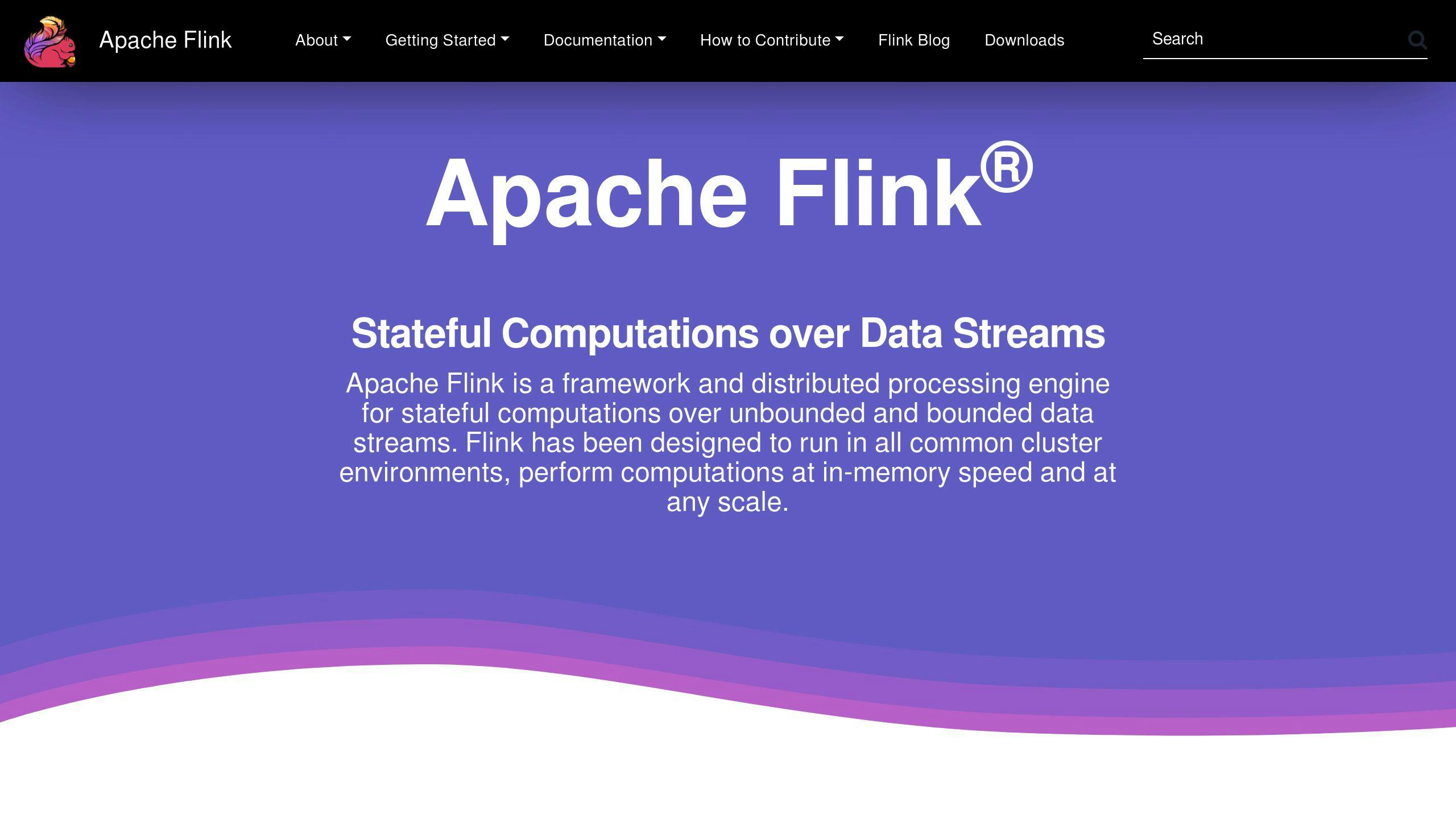Looking for the best real-time analytics tools for 2025? Start here.
Real-time analytics is essential for marketers who need instant insights to optimize campaigns and track user behavior. Four standout tools dominate the landscape: Apache Spark, Apache Flink, Apache Storm, and Google BigQuery. Here's a quick breakdown:
- Apache Spark: Fast, scalable, and cost-efficient for large datasets.
- Apache Flink: Ideal for continuous, real-time data streams with advanced machine learning features.
- Apache Storm: Reliable for event-based analytics like fraud detection and sentiment analysis.
- Google BigQuery: Cloud-native, easy to use, and perfect for large-scale marketing analytics with minimal setup.
Quick Comparison
| Tool | Best For | Key Feature | Cost Model | Ease of Use |
|---|---|---|---|---|
| Apache Spark | Large datasets, quick insights | In-memory processing | Self-managed | Moderate |
| Apache Flink | Continuous real-time streams | Event-time processing | Self-managed | Moderate |
| Apache Storm | Event-based analytics | Distributed stream processing | Self-managed | Complex |
| Google BigQuery | Cloud-based analytics | Serverless architecture | Pay-as-you-go ($5/TB) | Easy |
Choose the tool that aligns with your goals - whether it's real-time campaign tracking, large-scale data analysis, or cloud-based simplicity. Dive into the details below to find the right fit for your needs.
Apache Flink Vs. Apache Spark Vs. Apache Storm: Which Data Processing Tool is Right for You

1. Apache Spark Overview
Apache Spark is a leading open-source analytics engine known for its ability to process data at lightning speed - up to 100 times faster than Hadoop MapReduce. Its in-memory processing capabilities make it ideal for handling large datasets and delivering instant insights, especially for marketers who need quick, data-driven decisions.
Fast and Efficient Processing
With its in-memory computation, Spark processes complex data streams in real time. This is especially useful for marketers who need to analyze customer behavior or adapt to shifting market trends without delay. Its real-time streaming API ensures continuous data processing for immediate insights.
Seamless Integration
Spark works effortlessly with various data formats like JSON and CSV, as well as platforms such as Apache Kafka and HDFS. This compatibility makes it easier for marketers to consolidate and analyze data from multiple sources.
Real-Time Dashboards and Reporting
Spark's real-time streaming API powers dynamic dashboards, offering instant access to performance metrics, historical data, and audience analysis. Plus, it supports multiple programming languages, making it versatile for different use cases.
Scalability for Growing Needs
As data loads increase, Spark can scale by simply adding more servers. This ensures reliable performance, even during high-traffic marketing campaigns.
Built-In Security Features
Spark prioritizes security with encryption, access controls, and strong authentication measures, helping organizations meet compliance requirements.
Cost Efficiency
Compared to traditional analytics tools, Spark can significantly cut down operational costs, making it a smart choice for scaling marketing efforts.
While Spark is a top choice for speed and scalability, tools like Apache Flink may offer alternative benefits for specific real-time analytics needs.
2. Apache Flink Overview
Apache Flink is an open-source framework designed for processing large volumes of real-time data. It stands out for its ability to handle continuous data streams with impressive speed and reliability, making it a go-to tool for marketers who need instant insights.
Stream Processing That Delivers
Flink's event-time processing ensures accurate results, even when data arrives late or out of order. This is especially useful for marketers tracking customer actions and campaign results in real time.
Easy Integration with Popular Tools
Flink works smoothly with tools like Kafka, RabbitMQ, and JDBC databases. This makes it simple to bring together data from different sources into one streamlined analytics system.
Built for Reliability
Flink guarantees data consistency and reliability through features like:
- Automated backups
- Fault tolerance
- Distributed processing
- Accurate data handling
Real-World Performance
Leading companies like Alibaba use Flink to handle millions of transactions every second. Its ability to perform at such a scale makes it perfect for managing high-demand marketing campaigns and customer data.
Tools for Advanced Analytics
With FlinkML, marketers can tap into real-time machine learning for predictive insights. This means smarter, faster decisions and the ability to fine-tune campaigns as they run. Flink also enables detailed audience segmentation and behavior tracking through its flexible data grouping features.
Scalable and Efficient
Flink adapts to growing demands without sacrificing speed or reliability. Key features include:
- Dynamic resource allocation
- Effective memory management
- High-throughput processing
- Real-time optimization
These capabilities ensure Flink performs consistently, even during high-traffic events or peak marketing seasons.
While Flink shines in real-time analytics, Apache Storm offers a different approach to stream processing. Next, we’ll dive into what makes Storm a strong choice for certain use cases.
sbb-itb-5174ba0
3. Apache Storm Overview
Apache Storm is a distributed system designed to process massive streams of data in real time. It enables continuous data processing, making it possible to gain immediate insights.
Lightning-Fast Data Processing
Storm is built to handle incredible volumes of data at high speeds. Each node in the system can process millions of data tuples per second. For example, Twitter uses Storm to analyze billions of tweets in real time, allowing them to identify trends and make recommendations instantly.
Flexible Integration Options
Storm stands out with its ability to integrate with a variety of systems and tools. It works seamlessly with:
- Message queues like RabbitMQ
- Storage systems such as Apache HBase and Apache Cassandra
- Programming languages including Java, Python, and Scala
A great example is Yahoo!, which uses Storm to manage real-time bidding and optimize ad campaigns by combining multiple data streams.
Reliability and Scalability
Storm is built with enterprise needs in mind. It offers features like automatic task redistribution, guaranteed message delivery, and fault tolerance. Its distributed design allows it to scale effortlessly, ensuring consistent performance even during traffic spikes.
Real-Time Analytics in Action
Storm is perfect for scenarios like fraud detection, real-time sentiment analysis, and personalized content delivery. Businesses can use it to spot suspicious activity, improve user engagement, or adjust budgets dynamically. For marketers, it enables live tracking of campaigns, audience segmentation, and optimizing ad performance on the fly.
Development and Maintenance Considerations
Implementing Storm requires thoughtful planning. Teams need to consider hardware resources, infrastructure integration, and the expertise required to manage the system. Fortunately, Storm is supported by detailed documentation and an active community, which helps ease the learning curve.
While Storm offers impressive speed and reliability, tools like Google BigQuery provide an alternative, focusing on cloud-based real-time analytics.
4. Google BigQuery Overview

Cloud-Native Analytics Powerhouse
BigQuery takes the hassle out of infrastructure setup and maintenance, letting teams focus on analyzing data instead. Its columnar storage and distributed query engine deliver lightning-fast performance, handling terabytes of data in seconds. For example, Spotify reduced processing times from hours to minutes, enabling real-time recommendations for its 400 million users.
Integration and Processing Capabilities
BigQuery works effortlessly with other Google Cloud services, as well as third-party tools like Tableau and Looker. It supports commonly used formats like CSV and JSON, making it easier to manage and analyze data within the Google Cloud ecosystem.
Real-Time Analytics Performance
With the ability to process up to 100,000 rows per second and deliver sub-second query responses, BigQuery powers live dashboard updates for massive datasets. This is a game-changer for marketers, enabling quick adjustments to campaigns, precise audience segmentation, and personalized content delivery at scale.
Robust Security
BigQuery prioritizes secure data handling with encryption both at rest and in transit. It provides detailed audit logs and complies with key regulations like GDPR and HIPAA. Access controls can be customized at the dataset, table, or column level, ensuring sensitive marketing data stays protected.
Cost-Effective Scaling
BigQuery's pay-as-you-go pricing model is perfect for fluctuating analytics needs. Users are charged based on the actual amount of data processed and stored, with costs scaling directly with usage - no need to worry about fixed infrastructure expenses.
Real-World Impact
"BigQuery's ability to process our entire customer interaction dataset in seconds has transformed how we approach campaign optimization", says Sarah Chen, Data Analytics Lead at Airbnb. "We've seen a 40% reduction in decision-making time for marketing campaigns since implementing BigQuery."
BigQuery shines in cloud-based scalability and ease of use, but its strengths should be weighed against tools like Apache Spark and Flink to determine the best fit for specific marketing needs.
Comparison of Tools: Strengths and Weaknesses
Real-time analytics tools each bring their own pros and cons, which influence how well they fit different scenarios. Here's a breakdown of how these tools perform across key metrics and requirements.
Processing Architecture Impact
Flink's stream processing delivers real-time precision, making it perfect for continuous data streams like Alibaba's e-commerce analytics. Spark, with its micro-batch setup, handles large-scale, high-volume data efficiently with minimal delays, though it's not as immediate as Flink.
Integration and Ecosystem Compatibility
For marketers, seamless integration is essential to unify data and streamline workflows. Here's a quick look at how these tools stack up:
| Tool | Integration Options | Ecosystem Support |
|---|---|---|
| Apache Spark | Broad third-party support | Hadoop, Hive, Kafka |
| Apache Flink | Native streaming connectors | Kafka, HDFS, S3 |
| Apache Storm | Limited but reliable | Kafka, HDFS |
| Google BigQuery | Focused on Google Cloud | Google Cloud Services |
Performance and Scalability Metrics
Spark shines in handling massive datasets quickly, while BigQuery stands out with its near-instant query responses, making it ideal for live dashboard updates. Each tool has unique strengths for marketing tasks like campaign tracking or audience insights.
Cost Considerations and Resource Requirements
Here's how costs and infrastructure needs compare:
| Tool | Operational Costs | Infrastructure Needs |
|---|---|---|
| Apache Spark | Infrastructure + Maintenance | Self-managed |
| Apache Flink | Infrastructure + Expertise | Self-managed |
| Apache Storm | High maintenance | Self-managed |
| Google BigQuery | $5/TB processed | Fully managed |
Security and Compliance Framework
Security varies across tools. BigQuery offers built-in compliance for standards like GDPR and HIPAA, while open-source tools require tailored setups to meet regulatory needs.
Real-World Application Success
Companies like Netflix and Alibaba highlight the capabilities of these tools. Netflix uses Spark for personalized recommendations, while Alibaba relies on Flink for real-time e-commerce analytics. With AI and machine learning playing a growing role, tools like Flink and BigQuery are adding predictive features for smarter, real-time decisions.
Learning Curve and Support Resources
The ease of learning and available support can impact how quickly teams adapt. Google BigQuery is the easiest to get started with, thanks to its detailed documentation and support. On the other hand, Apache Storm demands more technical expertise for effective use.
Choosing the right tool comes down to aligning its strengths and limitations with your goals and technical needs. Up next, we'll share actionable tips to help you make the best choice.
Final Thoughts and Recommendations
After diving into the top real-time analytics tools for 2025, some clear trends emerge for marketing applications. Apache Flink stands out for real-time processing, making it perfect for tasks like fraud detection and live campaign tracking. On the other hand, Google BigQuery shines in advanced marketing analytics thanks to its serverless architecture and AI features.
Here’s a quick guide to help you pick the right tool based on your needs:
| Marketing Priority | Recommended Tool | Key Advantage |
|---|---|---|
| Real-time Campaigns & Event Processing | Apache Flink | Handles data instantly |
| Large-scale Data Analysis | Google BigQuery | Scales automatically |
| Complex Event Processing | Apache Storm | Processes events quickly |
Google BigQuery is especially appealing for beginners, thanks to its detailed documentation. It also integrates seamlessly with popular marketing tools and includes strong security measures - essential for teams working with sensitive customer data.
Big brands provide great examples of these tools in action. Netflix uses Apache Spark to deliver personalized recommendations, while Airbnb relies on Google BigQuery for its large-scale marketing analytics.
To get the most value, start with a pilot project. This approach ensures the tool you choose aligns with your goals and can scale as needed. With AI integration becoming more prominent, these tools will continue to evolve, offering even more opportunities for marketers.
The best choice ultimately depends on your specific marketing priorities, but keeping an eye on emerging trends like AI will help you stay ahead.


